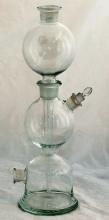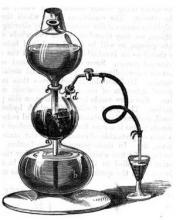Kipp's apparatus, also called Kipp generator, is an apparatus designed for preparation of small volumes of gases. It was invented around 1844 by the Dutch pharmacist Petrus Jacobus Kipp and widely used in chemical laboratories and for demonstrations in schools into the second half of the 20th century.It later fell out of use, at least in laboratories, because most gases then became available in small gas cylinders.
This apparatus is made of three vertically stacked glass. The upper chamber extends downward as a tube that passes through the middle chamber into the lower chamber. There is no direct path between the middle and upper chambers, but the middle chamber is separated from the lower chamber by a retention plate, such as a conical piece of glass with small holes, which permits the passage of liquid and gas. The solid material (e.g., iron sulfide) is placed into the middle chamber in lumps sufficiently large to avoid falling through the retention plate. The liquid, such as an acid, is poured into the top chamber. Although the acid is free to flow down through the tube into the bottom chamber, it is prevented from rising there by the pressure of the gas contained above it, which is able to leave the apparatus only by a stopcock near the top of the middle chamber. Gas is evolved from this reaction. When the stopcock is closed, the pressure of the evolved gas in the middle chamber rises and pushes the acid back down into the bottom chamber, until it is not in contact with the solid material anymore. At that point the chemical reaction comes to a stop, until the stopcock is opened again and more gas is drawn off.


